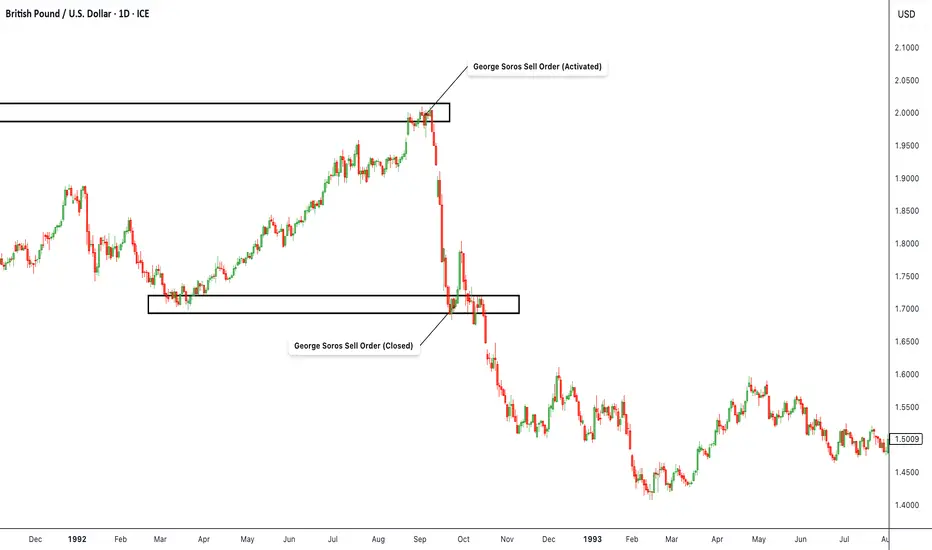Historical Context Summary:
This chart revisits the iconic 1992 short by George Soros against the British Pound, which ultimately forced the UK to abandon its currency peg and exit the European Exchange Rate Mechanism (ERM). The marked zones reflect the approximate levels where Soros reportedly initiated and closed his short position, anticipating a collapse of the GBP against the USD.
Real-time Trade Thesis:
Soros identified that the British economy was fundamentally too weak to sustain a fixed exchange rate against the Deutsche Mark, enforced through the ERM. Inflation was high, the economy was slowing, and the government was hiking rates and burning through reserves to defend the pound. Meanwhile, Germany’s economy was far stronger, making the GBP significantly overvalued relative to its fundamentals.
The Quantum Fund went short over £10 billion worth of GBP using highly leveraged positions, primarily via GBP/USD. On September 16, 1992 ("Black Wednesday"), the Bank of England capitulated after failing to hold the peg, and the pound collapsed—securing Soros one of the most profitable trades in history with over $1 billion in gains.
Technical Analysis Context:
This GBP/USD chart highlights the upper “order activation” zone where Soros began scaling into his short, as price stalled near the artificially defended level. As speculative pressure intensified, the central bank’s interventions failed, leading to a violent breakdown. The lower box marks the approximate range where Soros likely began closing the trade and locking in profit as the peg failed and panic selling set in.
Key Lessons:
This chart revisits the iconic 1992 short by George Soros against the British Pound, which ultimately forced the UK to abandon its currency peg and exit the European Exchange Rate Mechanism (ERM). The marked zones reflect the approximate levels where Soros reportedly initiated and closed his short position, anticipating a collapse of the GBP against the USD.
Real-time Trade Thesis:
Soros identified that the British economy was fundamentally too weak to sustain a fixed exchange rate against the Deutsche Mark, enforced through the ERM. Inflation was high, the economy was slowing, and the government was hiking rates and burning through reserves to defend the pound. Meanwhile, Germany’s economy was far stronger, making the GBP significantly overvalued relative to its fundamentals.
The Quantum Fund went short over £10 billion worth of GBP using highly leveraged positions, primarily via GBP/USD. On September 16, 1992 ("Black Wednesday"), the Bank of England capitulated after failing to hold the peg, and the pound collapsed—securing Soros one of the most profitable trades in history with over $1 billion in gains.
Technical Analysis Context:
This GBP/USD chart highlights the upper “order activation” zone where Soros began scaling into his short, as price stalled near the artificially defended level. As speculative pressure intensified, the central bank’s interventions failed, leading to a violent breakdown. The lower box marks the approximate range where Soros likely began closing the trade and locking in profit as the peg failed and panic selling set in.
Key Lessons:
- Pegged currencies can’t defy economic fundamentals forever.
- Macro conviction + tactical timing = asymmetric return.
- Central banks can lose to coordinated market pressure.
- Use leverage wisely, only when your thesis is airtight.
- Liquidity stress often precedes capitulation—watch reserve flows and bond yields.
- History leaves patterns—legendary trades repeat in new forms across cycles.
Disclaimer
The information and publications are not meant to be, and do not constitute, financial, investment, trading, or other types of advice or recommendations supplied or endorsed by TradingView. Read more in the Terms of Use.
Disclaimer
The information and publications are not meant to be, and do not constitute, financial, investment, trading, or other types of advice or recommendations supplied or endorsed by TradingView. Read more in the Terms of Use.
